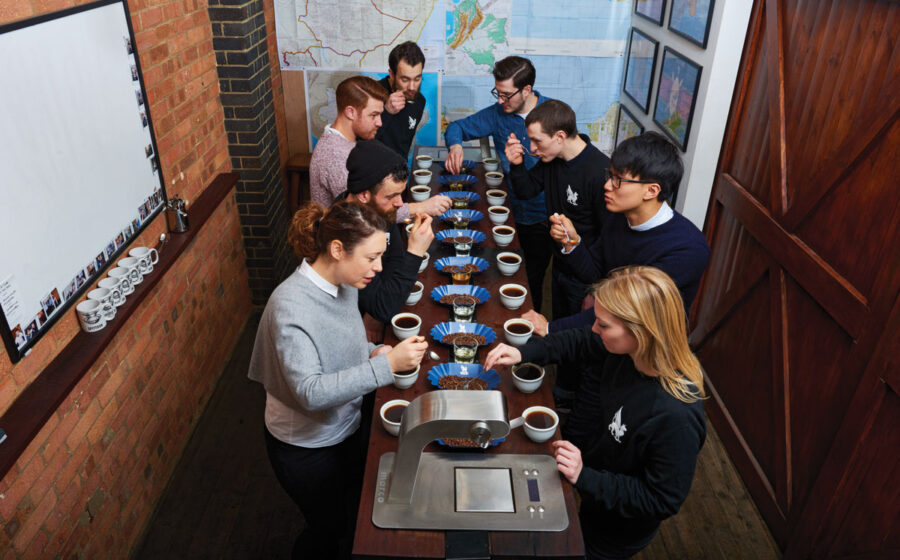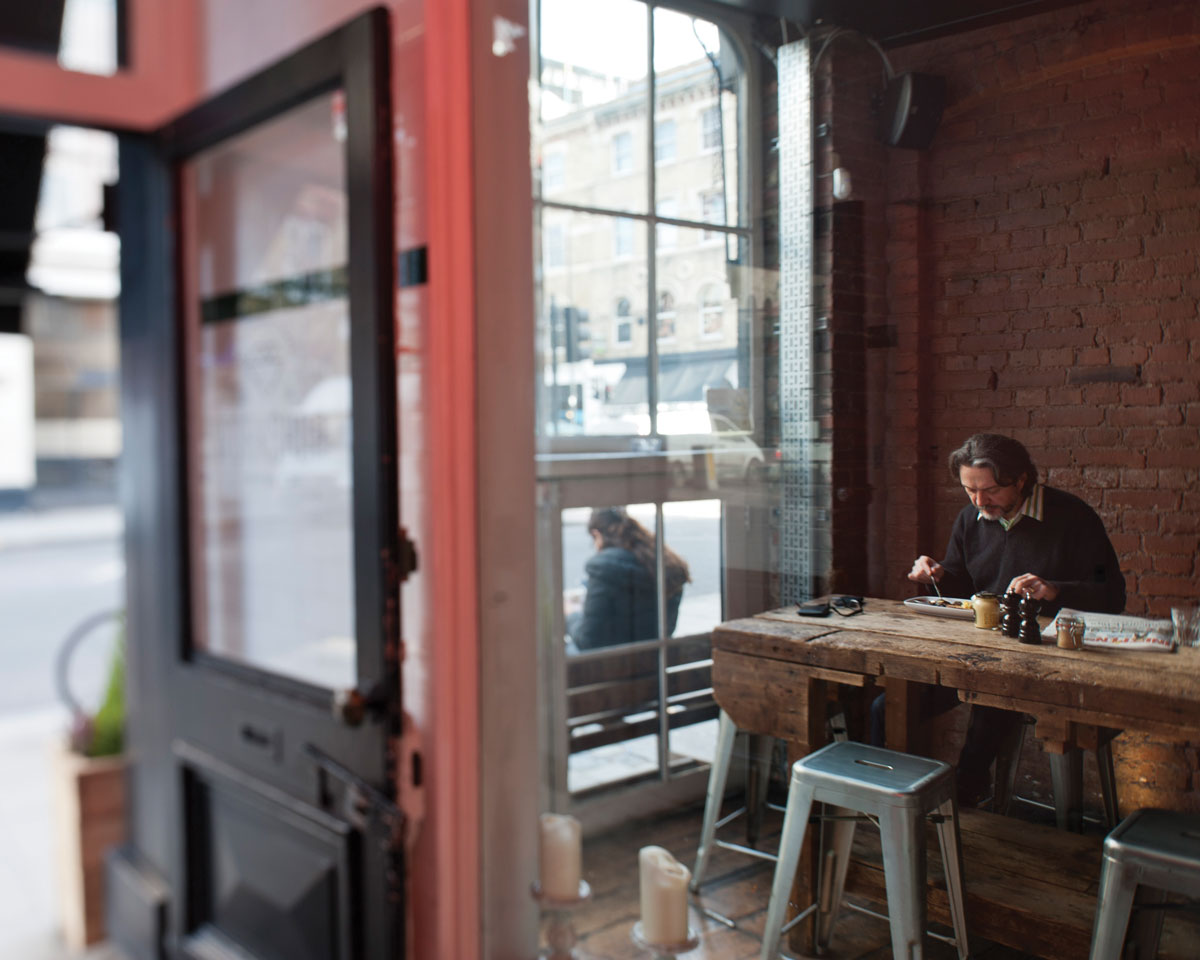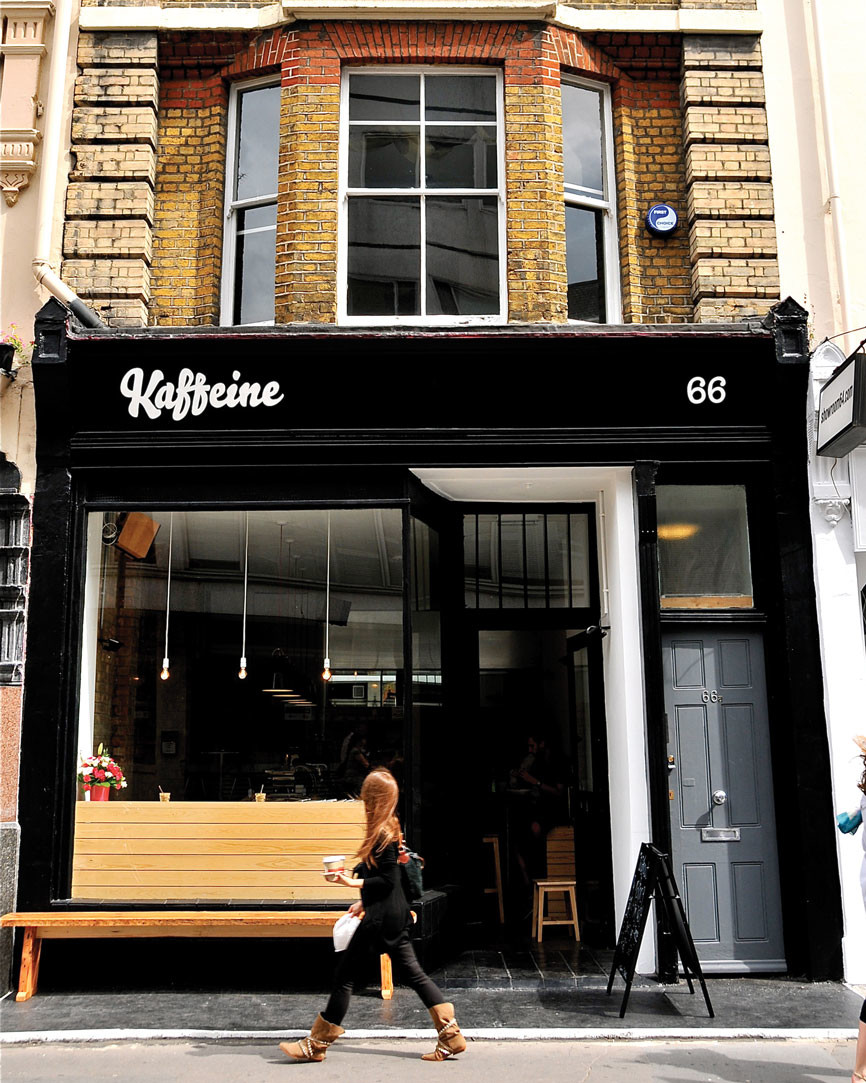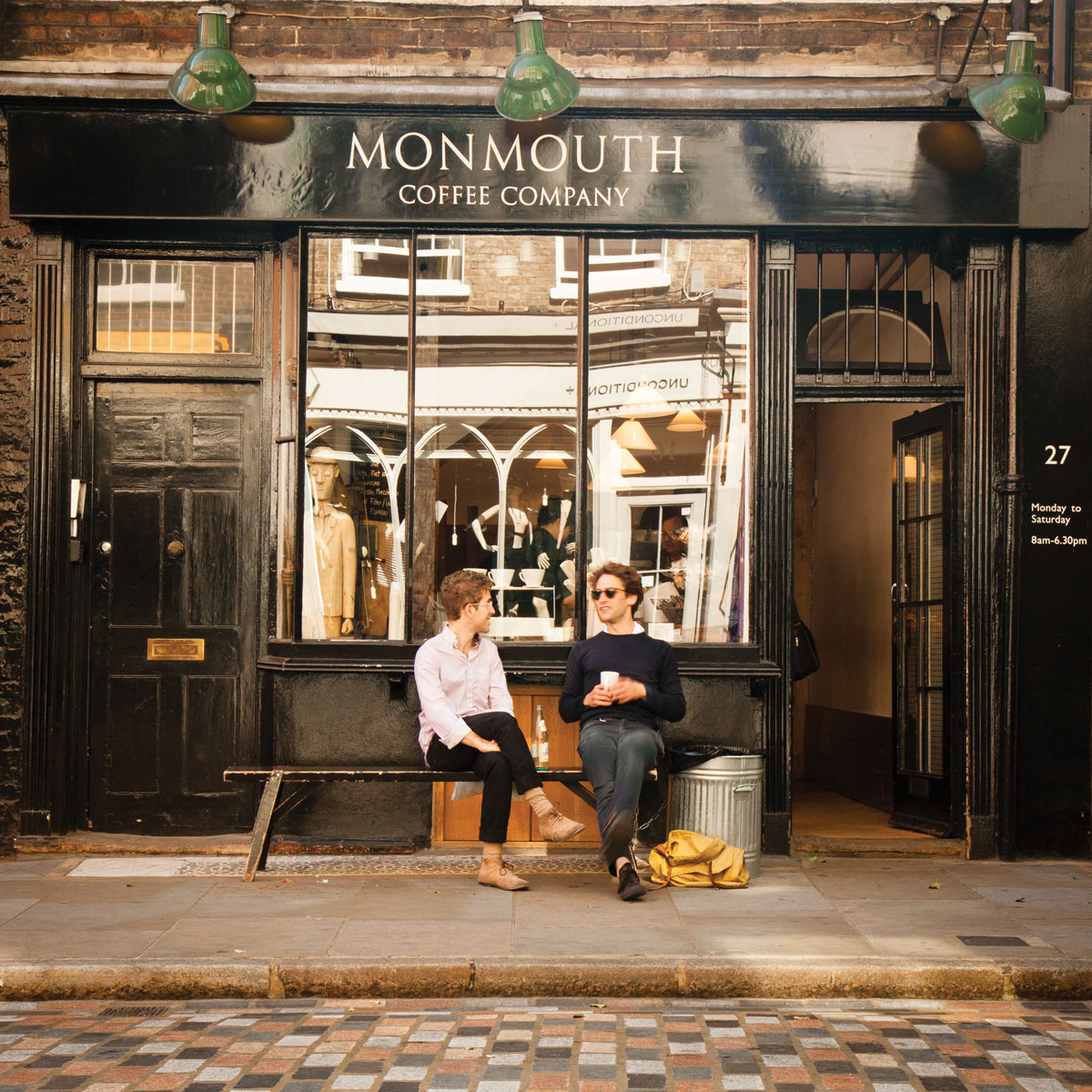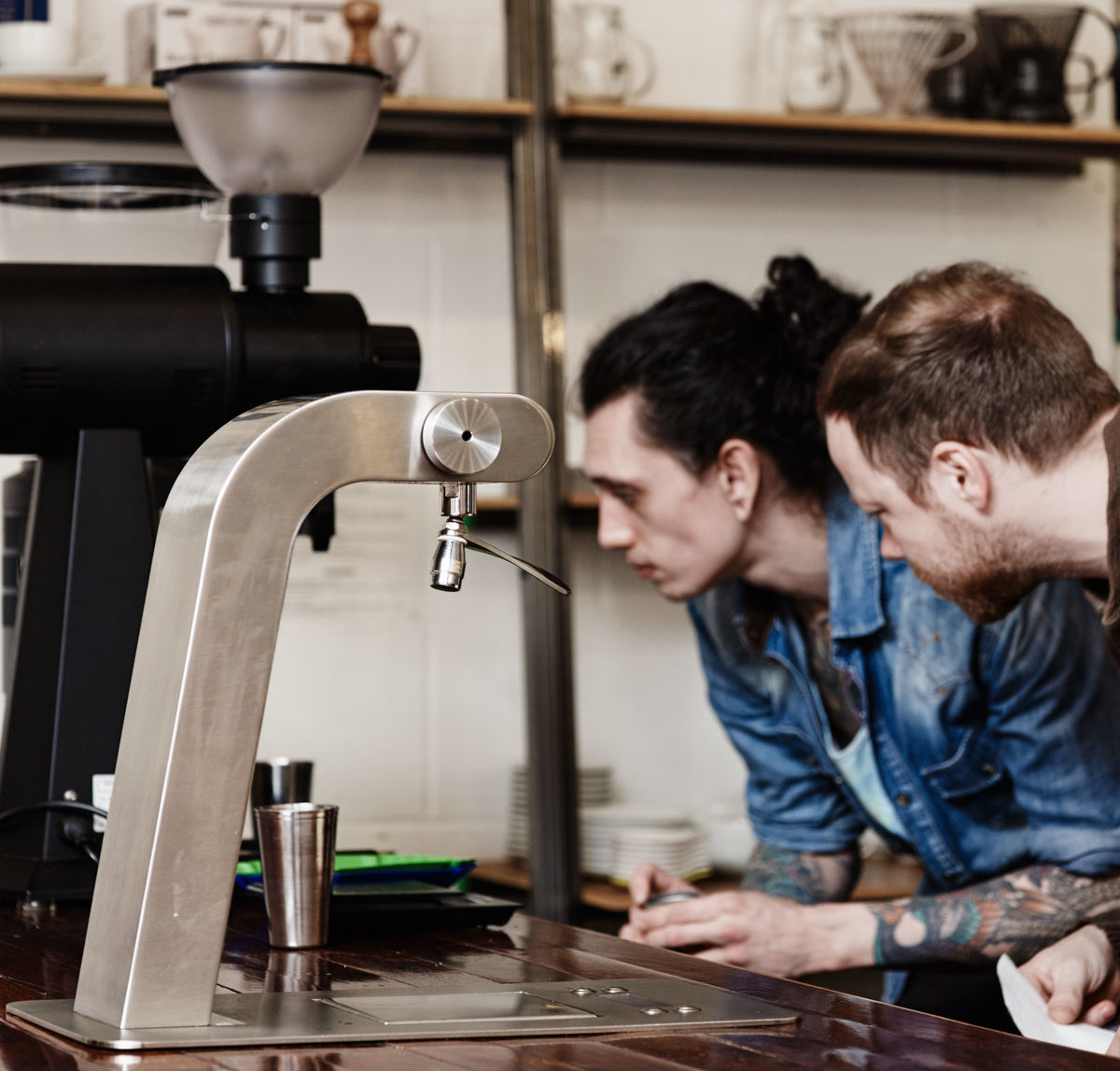[W]hen examining the origin of a sub-culture, institution, industry, or movement, there’s a neat storytelling trick to make things simpler and more compelling. Instead of detailing the small and disjointed moments, the grungy swirl of context, and the huge, often unknowable, number of people involved in the thing under examination, writers will pin the start to one particular point in time. So the Reformation begins with Luther, a hammer, and a door; the Bastille goes down and republicanism erupts across Europe; punk is born as the Sex Pistols play the Nashville. None of these starting points is wrong, necessarily, they’re just not messy enough to be true. They don’t show how often beginnings are made of halting, herky-jerky stumbles forward.
The London specialty coffee scene offers plenty of potential origin stories. You could start with the opening of Seattle Coffee Company in 1995 or jump ahead three years to when it sold its fifty-six stores to Starbucks and the world behemoth stepped into Europe. You could bounce up a decade to when Anette Moldvaer and James Hoffmann won the World Cup Tasters and World Barista Championships, respectively, and opened Square Mile Coffee Roasters a year later. Or you could pop back to 2005 when a New Zealander funded by an Aussie brought a Southern Hemisphere-style café to Soho and named it Flat White. A deep dive would go back to the late seventies when Anita Le Roy opened Monmouth Coffee.
All of these events, and plenty more, offered fuel to a smoldering coffee culture and set off flares that grabbed press attention and reeled in future coffee pros, but none caused an eruption. For the story of coffee in London there’s no one burst that created the industry, but there may be a point where the mass of the city’s coffee knowledge and community came close enough together to energize and go critical, setting off the city’s sustained boom of cafés and roasteries.
Several months after opening Square Mile in the spring of 2008, Moldvaer and Hoffmann felt stymied in their attempts to foster a greater sense of community among London’s coffee people. They realized they were plugged in with more coffee pros outside of England than within. There was camaraderie among those in coffee, but there wasn’t a nexus. So Moldvaer and Hoffmann began hosting monthly cuppings at their roastery. Of course part of this was to build business, but in large part it was to gather the city’s coffee pros and geeks and showcase what coffee could be for those on the periphery. The focus was not on their coffees. They’d bring in roasts from Scandinavia and other regions in Europe, fly over coffee from the States, and pull espressos for the packed room.
“I remember going to the roastery (at Square Mile), the original one, and standing in the corner like a real Simple Simon nobody, and all these coffee geeks are standing around drinking espressos and talking coffee. It was amazing, fantastic. Like a secret club.” —Peter Dore-Smith, Kaffeine
Moldvaer and Hoffmann were preaching the gospel of better coffee, and they attracted the city’s coffee choir, who helped with the mission. There were plenty of potential converts. In 2008, most cafés still were not competing on quality, Hoffmann says. They were relying on location (an especially brutal strategy with London’s stratospheric rents) or they were undercutting Starbucks and the other chains, with disastrous results for the coffee.
For Peter Dore-Smith, that meant it was nearly impossible to find a quality cup of coffee. In 2005 Dore-Smith moved from Melbourne to London for a second time, so he wasn’t shocked when he couldn’t find the quality of coffee that had spread through his hometown. One day, though, he was walking in Soho and stumbled upon Flat White. He immediately called his wife. Then he began scheming.
At the time, Dore-Smith worked in the catering department at Marylebone Cricket Club at the Lord’s Cricket Grounds, a sports venue as fancy as its name. The job was part of a career in hospitality that had started when Dore-Smith was eighteen. For most of that time, he had wanted to open a shop—a bar, a restaurant, a café, he wasn’t sure. After seeing Flat White, he knew. “There’s an opportunity here because I think there’s a demand for it. There was nothing in London at the time,” he says. “We were walking the streets trying to find coffee.” For the next four years he saved money, developed his business plan, scouted locations. And then he stumbled upon Square Mile’s cupping sessions.
“I remember going to the roastery, the original one, and standing in the corner like a real Simple Simon nobody, and all these coffee geeks are standing around drinking espressos and talking coffee,” Dore-Smith says. “It was amazing, fantastic. Like a secret club. . . . A whole lot of early days people were there.” They were eager to bring him in.
Dore-Smith’s café, Kaffeine, was among those in the initial wave following those cuppings. Like Flat White, many had strong ties to the Southern Hemisphere. Aussies and Kiwis are so important to London’s cafés that saying so is a haggard cliché. Last year, Tim Williamson, the director of operations at Workshop Coffee Co., himself an Aussie, told Sprudge, “I think the whole Australian thing is starting to become a bit more nebulous, a bit more of a distant causality rather than the primary thing that journalists or punters gravitate to. And about time, too.” At the end of the last decade, though, they were establishing an archetypal café for London.
Kaffeine is among the best examples. The shop is small, with the bar taking up as much space as the seating. The bar is packed from end-to-end, and a major portion of the counter space is occupied by an array of food. Eats make up just under half of the café’s revenue. “It’s fairly important to have,” Dore-Smith deadpans. Though the food is all made for takeout (per city licensing regulations), it’s made in-house by a full kitchen staff and the menu changes weekly. High-quality food, not just a pastry case, has become a requisite of London’s cafés. On the coffee end of the bar, every drink is made on the café’s Synesso, with flat whites comprising a third of all coffees. There is no filter coffee, which is not odd in London. Kaffeine opened a second location in March, and Dore-Smith again chose to forego filter coffee. Brits just don’t fancy drip.
[L]ondon has birthed and abandoned two other café cultures in its history. The first, which makes a persuasive claim as Europe’s first, began in the mid-seventeenth century and boasted hundreds, maybe even thousands of coffeehouses. It lasted more than 150 years, fading out by the Victorian age. The second came in the 1950s, powered by Italians and espresso. That wave didn’t make it to the eighties. Marco Arrigo grew up with the owners and patrons of these cafés and worked in one after the heyday. He just opened Bar Termini, a café and cocktail bar with a black-tie and white-jacket staff and a nostalgic, though realistic, eye on those mid-century cafés. He’s worked in coffee for most of his life, working as a barista when he was twelve. He refuses to call the shots he pulled back then espressos and calls the milk drinks he made “latteccinos.” “Looking back at the rubbish I was serving people, I’m embarrassed. It was crap,” he says.
He began wholesaling illy coffee in 1994 and tried to sell it to cafés and eateries that favored spooning grounds out of ice cream tubs. Not that customers noticed. At home they drank soluble coffee (which is still common). When Seattle Coffee Company opened in London in 1995, armed with the American to-go model recently perfected by Starbucks, they entered an open market and soon had more than fifty cafés.
In one of them, twenty-two-year-old Jorge Fernandez was learning what the word barista meant. “It was so totally new that we didn’t totally know what we were doing,” says Fernandez, who in 2007 opened Fernandez and Wells, a six-store chain of coffee and wine bars. Learning coffee was exciting. For some it proved addictive. “There was great camaraderie amongst the guys we worked with.”
What didn’t exist was a clear future for a career. You could work as a barista, but what about opening a café? This was an era of mega-chains. Other coffee professions, like roasting, importing, or teaching, hardly existed. The decade saw some of coffee’s early champions enter the tiny industry, but plenty who might have opened a café or a roastery in a different market fell away.
[I]n the history of London coffee Anita Le Roy stands apart. Her roastery, Monmouth Coffee Company, began in 1978 and predates almost every coffee company by a quarter century. While she has two cafés, her focus has always been retail, and for its first two decades, Monmouth didn’t sell its coffees to cafés. From her retail shops she pushed coffee as a home beverage made, preferably, with ceramic filter cones. Without Monmouth, London coffee couldn’t have oh-those-kids lines like this one from Fernandez: “We talk about the current subculture of pour-overs, V60s, and that sort of thing. . . . I always find it amusing having made thousands of (pour-over) coffees during my time at Monmouth Coffee, and then over the last six or seven years the cool factor has just increased.”
“I had this idea when I started that it would be great to have single-origin coffees, microlots. And I hit a solid wall.” —Anita Le Roy, Monmouth Coffee Co.
There’s a hiccup in the perception of Monmouth, though few know it because the company has been a standard bearer of British specialty coffee longer than most London coffee people have been in the industry. The practices that define Le Roy’s business now, including buying the majority of Monmouth’s beans directly from growers, weren’t possible in 1978. Not even in 1988. “I had this idea when I started that it would be great to have single-origin coffees, microlots,” she says. “And I hit a solid wall. . . . It was tough having the ideas to do something and not having the means.”
The green coffee market at the time was built on containers of commodity beans destined for industrial-sized roasting, not a small roaster who wanted to buy bags and kept asking questions like, “Where did the coffee come from?” It came from Colombia. What more was there to know? Le Roy pushed for all the information she could get, but the importers often simply had none. The supply chain was so dense, so uninterested in traceability that single-origin meant only the country of origin. This lasted until the mid-nineties.
“The idea of selling specialty raw materials at any kind of premium was laughable when we started.” —Stephen Hurst, Mercanta
In 1996, a new coffee importer, Mercanta, opened in the UK with an eye on greater transparency and higher-grade coffee. It was only after Mercanta arrived that Le Roy created her first espresso blend, building it on a coffee that wasn’t just from Brazil, but from Fazenda Cachoeira near Pocos de Caldas in Minas Gerais. Le Roy now had an avenue to get the coffees and information about them she had always wanted. (The Internet and Cup of Excellence were major developments at this time as well.) These were the coffees that 2009 World Barista Champion Gwilym Davies used when he opened his first kiosk cafés; one was a Yirgacheffe that exploded Fernandez’s notions of what coffee could be. The presence of these beans would bolster London coffee in the future, but outside of Monmouth, Stephen Hurst, the owner of Mercanta, had few roasteries clamoring for his product. “There was no business here, no market,” he says. “The idea of selling specialty raw materials at any kind of premium was laughable when we started.”
Since opening Monmouth, Le Roy always believed that for coffee to kick off hard, the city needed more roasteries. That would create a market, that would foster competition, that would push quality. “That wasn’t happening,” she says.
[I]n 2008, Aussies and Kiwis weren’t just overrepresented as owners, they made up a huge portion of the city’s barista corps. That’s not the case anymore, and the range of accents behind the bar covers the British Isles and plenty of Europe. The expectations of the baristas have changed, too. “You see relatively young baristas who being a barista is what they want to do,” says Fernandez. “They want to work in coffee. That culture didn’t exist back then.”
Baristas now see pathways to a career in coffee. They could open a café, sure, but they could also train wholesale clients, they could roast, they could manage shops, they could teach, they could source beans. The expansion of the number and type of coffee jobs can keep talent in the coffee industry. Just as Le Roy has said for decades, it was an explosion of roasters that created this ecosystem.
“You see relatively young baristas who being a barista is what they want to do. They want to work in coffee. That culture didn’t exist back then.” —Jorge Fernandez, Fernandez and Wells
If the first decade of this century saw the rise of cafés in London, this one belongs to roasteries. Mike Riley, the head of coffee importer Falcon Speciality, counts seventy-two roasteries in London on his contact list, though he expects he’s missing one or two. “I think we’ll go past a hundred,” he says. And few will be jokers. Most often new roasteries are, Riley says, “born out of people who have been baristas. They might have been a roaster for somebody else. They’re already quite enthusiastic about coffee.” These new, small roasters are the reason Falcon Speciality even exists. The importer’s parent company, Falcon Coffee, which itself is only about seven years old, trades in container-sized orders but noticed that more and more roasters wanted small quantities, like five, maybe ten bags. So not quite three years ago, Falcon created the specialty branch. With market reactions like this, and plenty of success to emulate, the barriers to roasting are crumbling.
That doesn’t mean there’s an open field to stake a claim, whether that’s to build a café or a roastery. While the number of coffeehouses, roasteries, and now even roaster-retailers grows, the amount of coffee Brits drink seems to have stagnated some time ago. For Marco Arrigo that’s a sure sign of a bubble and a major reason his bar is as worried about the quality of its cocktails as its espressos. “Nobody has gold teeth and a Ferrari in this industry,” he says. (Bonus Arrigo quip on over-professionalization: “They’ve built up baristas to be bigger than a barrister.”)
Hoffmann, though ever the champion of coffee in his city, is haunted by the ghosts of café cultures past. “Three times now, London’s boomed and twice it’s bust. I can’t be all cocky and confident and say this will keep going,” he says. “It has no precedent of staying, looking at our past.” The optimistic view of the UK’s coffee drinking is that though there might not be a change in volume, there’s a change in kind. Look at beer, look at food in Britain, several people said: once a coffee drinker moves from soluble to specialty coffee, she’s not going to backslide.
Jeremy Challender, while not a Pollyanna, doesn’t have much time for doomsday talk. “London is now in its Golden Age. Cafés and roasteries are only getting better,” says Challender, who owns Prufrock Coffee with Gwilym Davies and has worked in coffee since 2002. “Even though it’s fiercely competitive now, the businesses that are surviving and doing well are increasingly focused on costs and wastage and staff development and traceability.” If a café dies it redounds on the quality of the shop, not the state of coffee.
In about ten years London’s boney coffee scene fleshed out, then bulked up to be a world heavyweight. The close-knit tribe of coffee pros became a proper industry, one where doing coffee the right way is as much a matter of fiscal survival as pride. For the most part, the people who gathered to cup coffees at Square Mile in 2008 relish this. But they miss that time.
There’s something incredible about listening to people being wistful about the end of an era when that era began less than a decade ago. It’s like being nostalgic for high school the summer after graduation. A decade ago, even just five years ago, when the industry could fit inside the teacup the British press is so worried the nation has smashed in favor of a coffee mug, everyone knew everyone. The industry is too big for that now. The city’s coffee pros couldn’t fit in Square Mile’s roastery now, not even the new, bigger one. Which is how it should be for London.
—Cory Eldridge is Fresh Cup’s editor. Follow him on Twitter @CoryEldridge.



